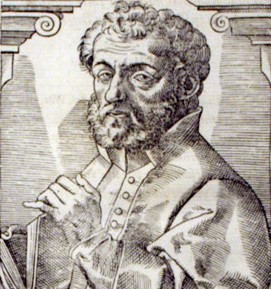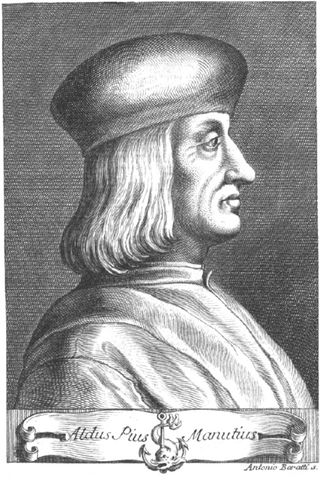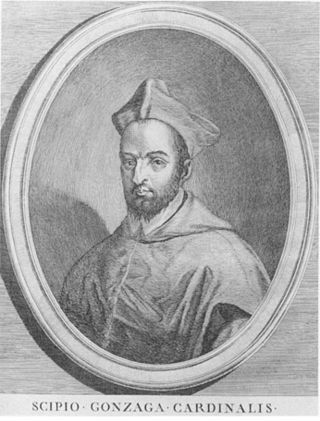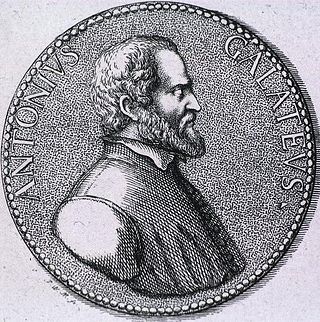Related Research Articles

Theocritus was a Greek poet from Sicily, Magna Graecia, and the creator of Ancient Greek pastoral poetry.

George of Trebizond was a Byzantine Greek philosopher, scholar, and humanist.

Aldus Pius Manutius was an Italian printer and humanist who founded the Aldine Press. Manutius devoted the later part of his life to publishing and disseminating rare texts. His interest in and preservation of Greek manuscripts mark him as an innovative publisher of his age dedicated to the editions he produced. Aldus Manutius introduced the small portable book format with his enchiridia, which revolutionized personal reading and are the predecessor of the modern paperback book. He also helped to standardize use of punctuation including the comma and the semicolon.

Federico Barocci was an Italian Renaissance painter and printmaker. His original name was Federico Fiori, and he was nicknamed Il Baroccio. His work was highly esteemed and influential, and foreshadows the Baroque of Rubens. He is generally considered the greatest and the most individual painter of his time in central Italy.

Domenico Grimani was an Italian nobleman, theologian and cardinal. Like most noble churchman of his era Grimani was an ecclesiastical pluralist, holding numerous posts and benefices. Desiderius Erasmus dedicated his Musica to Grimani.

The Duchy of Urbino was an independent duchy in early modern central Italy, corresponding to the northern half of the modern region of Marche. It was directly annexed by the Papal States in 1631.
Rajmund Kunić or Raimondo Cunich was a Latin and Greek humanist from Dubrovnik, Republic of Ragusa.

Scipione Gonzaga was an Italian cardinal, chiefly remembered for his friendship and patronage of the troubled poet Torquato Tasso and his support, against other family members, for his cousin Saint Aloysius Gonzaga.
Martino da Como, was an Italian 15th-century culinary expert who was unequalled in his field at the time and could be considered the Western world's first celebrity chef. He made his career in Italy and was the chef at the Roman palazzo of the papal chamberlain ("camerlengo"), the Patriarch of Aquileia. Martino was applauded by his peers, earning him the epitaph of the prince of cooks. His book Libro de Arte Coquinaria is considered a landmark in Italian gastronomic literature and a historical record of the transition from medieval to Renaissance cuisine.

The Diocese of San Marino-Montefeltro, known until 1977 as the Diocese of Montefeltro, is a Latin Church ecclesiastical jurisdiction or diocese of the Catholic Church in both Italy and San Marino. It is a suffragan in the ecclesiastical province of the metropolitan Archdiocese of Ravenna-Cervia. The current diocese includes all the parishes of San Marino.

Timoteo Viti, sometimes called Timoteo della Viti or Timoteo da Urbino, was an Italian Renaissance painter, who was closely associated with Raphael, who was fourteen years his junior.
Nationality words link to articles with information on the nation's poetry or literature.
Nationality words link to articles with information on the nation's poetry or literature.

Antonio de Ferraris, also known by his epithet Galateo, was an Italian scholar, academic, doctor and humanist, of Greek descent.

Summa de arithmetica, geometria, proportioni et proportionalita is a book on mathematics written by Luca Pacioli and first published in 1494. It contains a comprehensive summary of Renaissance mathematics, including practical arithmetic, basic algebra, basic geometry and accounting, written for use as a textbook and reference work.

Antoine du Pérac Lafréry (1512–1577), better known as Antonio Lafreri, was a Burgundian engraver, cartographer and publisher active in Rome.

Vettor Fausto or Vittore Fausto (1490–1546) was Venetian Renaissance humanist and naval architect. He was an expert in Greek and the classics. He worked as a copyist and a soldier in his youth. His studies led him to propose the construction of a quinquereme, a galley with five rowers per bench. He published original poetry in Greek, had a hand in the publication of the Complutensian Polyglot Bible and edited classical texts for publication, most notably the Aristotelis Mechanica, which he translated into Latin. In his later years he grew disillusioned with Venetian politics, even being accused of treason.
Antonio Bruni was an Italian Marinist poet. He was one of the most successful of Marino's followers.

Andrea Brenta, also known as Andreas Brentius, was an Italian Renaissance humanist, professor and Greek–Latin translator.
References
- ↑ "FILETICO, Martino - Enciclopedia". Treccani (in Italian). Retrieved 4 November 2024.
- ↑ "Martino Filetico (1430-1490)". ferentino.org (in Italian). Retrieved 4 November 2024.
- ↑ "Martino Filetico". Oxford Reference. Retrieved 4 November 2024.